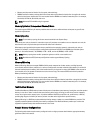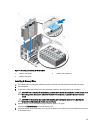
• Memory modules must be identical in size, speed, and technology.
• DIMMs installed in memory sockets with white release tabs must be identical and similar rule applies for sockets
with black and green release tabs. This ensures that identical DIMMs are installed in matched pairs - for example,
A1 with A2, A3 with A4, A5 with A6, and so on.
NOTE: Advanced ECC with Mirroring is supported.
Memory Optimized (Independent Channel) Mode
This mode supports SDDC only for memory modules that use x4 device width and does not impose any specific slot
population requirements.
Memory Sparing
NOTE: To use memory sparing, this feature must be enabled in the System Setup.
In this mode, one rank per channel is reserved as a spare. If persistent correctable errors are detected on a rank, the
data from this rank is copied to the spare rank and the failed rank is disabled.
With memory sparing enabled, the system memory available to the operating system is reduced by one rank per
channel. For example, in a dual-processor configuration with sixteen 4 GB dual-rank DIMMs, the available system
memory is: 3/4 (ranks/channel) × 16 (DIMMs) × 4 GB = 48 GB, and not 16 (DIMMs) × 4 GB = 64 GB.
NOTE: Memory sparing does not offer protection against a multi-bit uncorrectable error.
NOTE: Both Advanced ECC/Lockstep and Optimizer modes support Memory Sparing.
Memory Mirroring
Memory Mirroring offers the strongest DIMM reliability mode compared to all other modes, providing improved
uncorrectable multi-bit failure protection. In a mirrored configuration, the total available system memory is one half of
the total installed physical memory. Half of the installed memory is used to mirror the active DIMMs. In the event of an
uncorrectable error, the system will switch over to the mirrored copy. This ensures SDDC and multi-bit protection.
Memory installation guidelines:
• Memory modules must be identical in size, speed, and technology.
• DIMMs installed in memory sockets with white release levers must be identical and similar rule applies for sockets
with black and green release tabs. This ensures that identical DIMMs are installed in matched pairs - for example,
A1 with A2, A3 with A4, A5 with A6, and so on.
Fault Resilient Memory
Fault Resilient Memory (FRM) mode operates with the parts of redundant system memory, leaving the rest of the system
memory in non-mirror mode. It reduces the cost of memory mirroring by mirroring just the critical portion of memory
versus mirroring the entire memory space. It provides additional flexibility to optimize cost, performance, or RAS by
providing high degree of reliability to memory at lower cost than mirroring the entire system memory.
Memory Mirroring is a RAS feature that enables duplicating memory content at a remote DIMM in the partition. This
capability enables high data availability from memory subsystem. Fault Resilient Memory enables you to select the
segments of system memory that contains the most critical code.
Sample Memory Configurations
The following table shows sample memory configurations for a single processor that follow the appropriate memory
guidelines stated in this section.
44


















